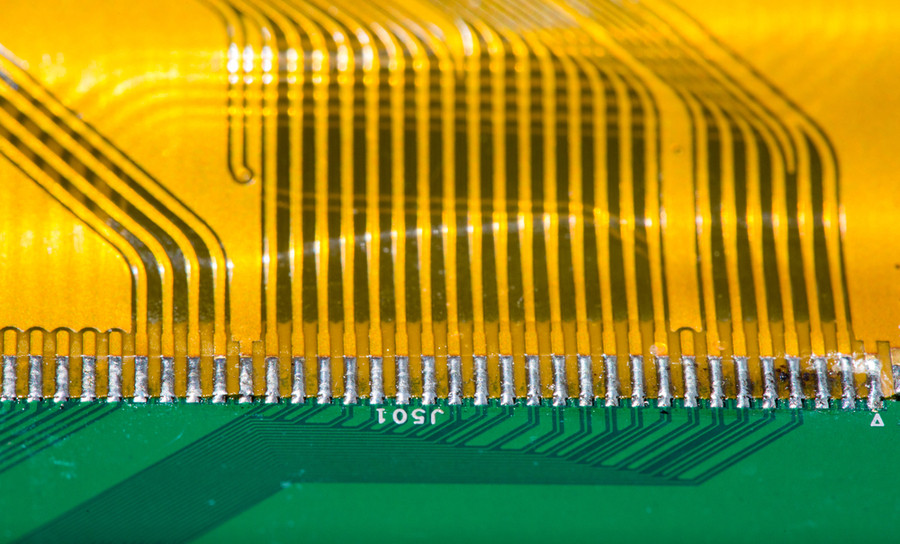FPC Base Materials

As someone new to designing with flex materials, what is important to understand about the base materials?
For people new to designing with flex materials, it can be a little intimidating, there're so many options to choose from, it can be mind-boggling. But once the basics are understood, the special circumstances can more easily be handled.
Here we only talk about flex-only constructions to help narrow the focus. Although there are many flexible materials, let’s start with the most common: laminate constructions with copper and polyimide.
There are two primary constructions for flex base materials, adhesive based and adhesiveless. Both are typically supplied with a layer of rolled-annealed copper and a layer polyimide. Adhesive-based materials can be with either standard acrylic adhesive, or flame retardant acrylic adhesive, depending on the end application requirements.
First, what is the difference between rolled annealed copper and electrodeposited copper?
Rigid materials are typically manufactured with electrodeposited (ED) copper. ED copper is formed by electrolytic deposition onto a slowly rotating polished drum from a copper-sulfate solution. When an electric field is applied, copper is deposited on the drum as it rotates at a very slow pace; the slower the pace, the thicker the copper. The side against the drum provides the smoother finish.
Flexible laminates are typically constructed with rolled annealed copper. Rolled annealed (RA) copper foils are created by successively passing an ingot of solid copper through a rolling mill, and then applying high temperature to anneal the copper. RA copper foil has higher ductility and elongation than ED copper which is why it is best for bending applications.
When would you select adhesiveless materials instead of adhesive-based materials?
Adhesive based materials are the workhorse of flexible circuit materials, especially for flex-only applications. They have been used for decades and are most commonly used in single and double-layer designs. These materials are typically lower cost than adhesiveless materials, and doesn’t that seem crazy? There is more material involved, but it is cheaper?
A typical adhesive based laminate will be constructed with a layer of copper, a layer of 1 mil adhesive, a layer of polyimide, another layer of adhesive, and a second layer of copper.
Adhesiveless material, as you would expect, eliminates the adhesive layers and typically reduces that double sided laminate by 2 mils.
Adhesiveless materials are most commonly used when the design is a higher layer count flex or a rigid flex construction. In both cases, adhesiveless material is recommended for quality and reliability reasons. The z-axis expansion rate of the acrylic adhesive is a concern for plated through hole integrity. In higher layer count, flex-only applications, there is also a material thickness concern. Eliminating 1 mil of adhesive thickness per copper layer can significantly decrease overall thickness and increase flexibility in the final product.
What material constructions are available?
There are so many material constructions available. Copper is typically available from 0.25 oz to 2 oz. This doesn’t mean that you can’t have copper thicker than 2 OZ, it simply means that your fabricator would need to create that laminate with raw copper, adhesive and polyimide, rather than purchasing a pre-made laminate. Adhesive thicknesses range from half mil to 2 mil. Polyimide thicknesses range from half mil to 5 mil. You can literally purchase nearly any combination of these materials and thickness if you have a specific end-use requirement.
What material constructions are most common and most available?
Just because you can spec in any combination of material thicknesses, doesn’t mean that is necessarily the best approach. If you are looking for the common constructions to help reduce both cost and lead-time associated with a special order, try to stick to constructions with 1 mil adhesive (if you are selecting adhesive-based materials), and a combination of 0.5 oz or 1 oz copper and 1 or 2 mil polyimide. These constructions are typically the most common constructions which often means lower cost and shorter lead-times to procure the material supplier and will help keep costs down with your flex stack-up.
What is more important than common material constructions to keep cost down?
Now which the most common materials are have been explained, which should be materials that are most readily available and lower cost, there is one more critical piece to this. That is, what material does your preferred fabricator stock? At the end of the day, each fabricator has a material WHERE set that they commonly stock and that will have a meaningful impact on your material costs and lead-time. Adhesive based material is less expensive than adhesiveless material. But, if your fabricator manufacturers a significant percentage of rigid flex or higher layer count flex, they will likely purchase more adhesiveless material, which reduces cost, and will likely have more of the adhesiveless material in stock, which reduces lead time. Most fabricators are happy to supply a stack-up for you. If you specifically ask more common materials, you can ensure materials that do not require a special order and should not require an extended lead time.
Capacités
Capacité PCB rigide
Capacité PCB flexible
Capacité d'assemblage PCB
Équipement PCB
Équipement d'assemblage PCB
Méthodes de paiement
Prix spéciaux
Transporteurs
Support pour amateurs
Certificat
Assistance clientèle
Suivez-nous
Tel: 1-905-339-2881
Email: [email protected] , [email protected]
Copyright Gold Phoenix PCB Co., Ltd. 2011 - 2023
Tel: 1-905-339-2881 Email: [email protected] , [email protected]
Système de contrôle qualité | Service produit
| Liens
Copyright Gold Phoenix PCB Co., Ltd. 2011 - 2023


